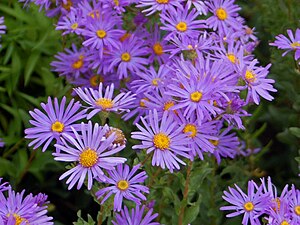Aster amellus
Σκηνὴ πᾶς ὁ βίος καὶ παίγνιον: ἢ μάθε παίζειν, τὴν σπουδὴν μεταθείς, ἢ φέρε τὰς ὀδύνας → All life is a stage and a play: either learn to play laying your gravity aside, or bear with life's pains.
Latin > Greek
ἀργεμώνιον, ἀστέριον, ἀστήρ, ἀστὴρ Ἀττικός, ἀστερίσκος, βουβώνιον
Wikipedia EN
Aster amellus, the European Michaelmas daisy, is a perennial herbaceous plant in the genus Aster of the family Asteraceae.
The specific name amellus is first used in the Georgics (Book IV, 271-280), a poem of the Latin poet Publius Vergilius Maro (70 BC - 19 BC), but the etymology is obscure and uncertain.
The English common name derives from the flowers being in bloom during Michaelmas (the Feast of St. Michael the archangel)
Also called: Amellus officinalis Gaterau; Amellus vulgaris Opiz; Aster acmellus Pall.; Aster albus Willd. ex Spreng.; Aster amelloides Hoffm.; Aster amellus subsp. bessarabicus Soó; Aster atticus Pall.; Aster bessarabicus Bernh. ex Rchb.; Aster collinus Salisb.; Aster elegans Nees; Aster noeanus Sch.Bip. ex Nyman; Aster ottomanum Velen.; Aster pseudoamellus DC.; Aster purpureus Gueldenst. ex Ledeb.; Aster scepusiensis Kit. ex Kanitz; Aster tinctorius Wallr.; Aster trinervius Gilib.; Diplopappus asperrimus DC.; Diplopappus laxus Benth.; Galatella asperrima Nees; Kalimares amellus Raf. ex B.D.Jacks.
Translations
Michaelmas daisy
English: blue daisy, Italian aster, European Michaelmas daisy, Michaelmas daisy, Italian starwort; Finnish: elokuunasteri; French: marguerite de la Saint-Michel; German: Berg-Aster; Ancient Greek: ἀστέριον, ἀστερίσκος, ἀστὴρ Ἀττικός, ὑόφθαλμος; Latin: amellus, Aster amellus; Welsh: blodyn Mihangel, ffarwel haf

